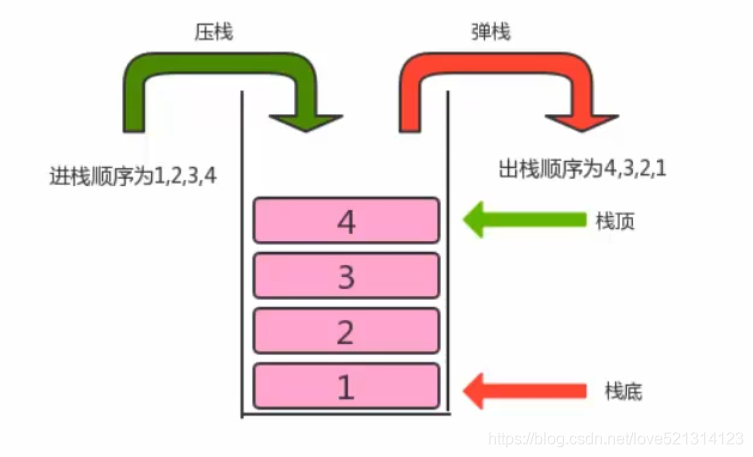1.3 栈
栈是一种先进后出的数据结构。只能在一端进行插入和删除操作的特殊线性表。
将数据进入栈称为压栈,数据出去称为弹栈。 在这里我们用链表的形式表示栈,感兴趣的同学也可以用顺序表的形式来表示。
在这里我们用链表的形式表示栈,感兴趣的同学也可以用顺序表的形式来表示。
压栈
public void push(T t){
//找到首结点指向的第一个结点
Node oldfirst = head.next;
//创建新结点
Node newNode = new Node(t,null);
//让首结点指向新结点
head.next=newNode;
//让新结点指向原来的第一个结点
newNode.next=oldfirst;
//元素个数+1
N++;
}
弹栈
public T pop(){
//找到首结点指向的第一个结点
Node oldfirst = head.next;
//测试是否出现空指针
if (oldfirst==null){
return null;
}
//让首结点指向第一个结点的下一个结点
head.next=oldfirst.next;
//元素个数-1
N--;
return oldfirst.item;
}
遍历数据
public Iterator<T> iterator() {
return new siterator();
}
public class siterator implements Iterator{
private Node n;
public siterator() {
this.n=head;
}
@Override
public boolean hasNext() {
return n.next!=null;
}
@Override
public Object next() {
n=n.next;
return n.item;
}
}
完整代码
public class Stack<T> implements Iterable<T>{
private Node head;
private int N;
public Stack() {
this.head = new Node(null,null);
this.N=0;
}
//创建内部类
private class Node {
T item;
Node next;
public Node(T item, Node next) {
this.item = item;
this.next = next;
}
}
public boolean isEmpty(){
return N==0;
}
public int size(){
return N;
}
//把t元素压入栈
public void push(T t){
//找到首结点指向的第一个结点
Node oldfirst = head.next;
//创建新结点
Node newNode = new Node(t,null);
//让首结点指向新结点
head.next=newNode;
//让新结点指向原来的第一个结点
newNode.next=oldfirst;
//元素个数+1
N++;
}
//把元素t弹出栈
public T pop(){
//找到首结点指向的第一个结点
Node oldfirst = head.next;
//测试是否出现空指针
if (oldfirst==null){
return null;
}
//让首结点指向第一个结点的下一个结点
head.next=oldfirst.next;
//元素个数-1
N--;
return oldfirst.item;
}
//遍历数据
@Override
public Iterator<T> iterator() {
return new siterator();
}
public class siterator implements Iterator{
private Node n;
public siterator() {
this.n=head;
}
@Override
public boolean hasNext() {
return n.next!=null;
}
@Override
public Object next() {
n=n.next;
return n.item;
}
}
}
1.4 队列
队列与栈不同,它是一种先进先出的数据结构,只能在一端进行插入,在另一端进行删除的线性表。
 插入元素
插入元素
public void enqueue (T t){
//当前尾结点为null
if (last==null){
last=new Node(t,null);
head.next=last;
}
//当前尾结点不为null
else{
Node oldlast=last;
last = new Node(t,null);
oldlast.next=last;
}
//元素个数+1
N++;
}
从队列取出元素
public T dequeue(){
if (isEmpty())
return null ;
Node oldfirst=head.next;
head.next=oldfirst.next;
N--;
//当队列中的元素删除完,需要重置last=null
if (isEmpty()){
last=null;
}
return oldfirst.item;
}
完整代码
public class Queue<T> implements Iterable<T>{
private Node head;
private int N;
private Node last;
public Queue() {
this.head = new Node(null,null);
N = 0;
this.last = null;
}
//创建内部类
private class Node {
T item;
Node next;
public Node(T item, Node next) {
this.item = item;
this.next = next;
}
}
public boolean isEmpty(){
return N==0;
}
public int size(){
return N;
}
//向队列中插入元素
public void enqueue (T t){
//当前尾结点为null
if (last==null){
last=new Node(t,null);
head.next=last;
}
//当前尾结点不为null
else{
Node oldlast=last;
last = new Node(t,null);
oldlast.next=last;
}
//元素个数+1
N++;
}
//从队列中取出元素
public T dequeue(){
if (isEmpty())
return null ;
Node oldfirst=head.next;
head.next=oldfirst.next;
N--;
//当队列中的元素删除完,需要重置last=null
if (isEmpty()){
last=null;
}
return oldfirst.item;
}
@Override
public Iterator<T> iterator() {
return new siterator();
}
public class siterator implements Iterator{
private Node n;
public siterator(){
this.n=head;
}
@Override
public boolean hasNext() {
return n.next!=null;
}
@Override
public Object next() {
n=n.next;
return n.item;
}
}
}
b站详细讲解网址:http://yun.itheima.com/course/639.html